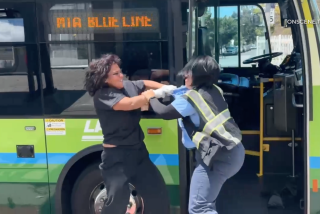Strike Causes Few Bumps in Road for O.C.
- Share via
Angelenos may have started the week as transit orphans because of the massive MTA strike, but H.G. Moss wouldn’t have known that feeling as he sat in an Orange County Transportation Authority bus early Monday, traveling to the center of bus-deprived Los Angeles.
“I’m going to be all right,” Moss said. At worst, the Huntington Beach business teacher said, he would just have to “use a little shoe leather” to walk five blocks to his job at the Job
Court trade school.
Except for the fact that route 701 from Huntington Beach to Union Station in downtown Los Angeles was initially routed away from picketers at the MTA headquarters and northbound freeway traffic swelled in crunch spots, things pretty much went like clockwork Monday morning.
The same probably could not be said for many of Moss’ students, working-class L.A. residents with few commuting options, Moss said.
“I may not have any students today,” Moss, 51, said. “My students are among the ones who are really going to suffer.”
If Orange County residents had worried the MTA strike would grow into a transit tsunami with far-reaching consequences, by Monday they found out it was a much gentler storm on this side of the county line. While the strike caused disruptions throughout L.A., especially among those who hop from bus to bus as part of their daily ritual, it had little effect in Orange County.
Even Orange County commuters who travel to jobs in downtown L.A using OCTA buses or trains felt little inconvenience. Each day about 750 people ride buses and 6,000 take Metrolink trains from Orange County to L.A., said OCTA spokesman George Urch. Many of these long-distance travelers take public transportation by choice, knowing that they could fall back on personal vehicles if push came to shove.
Metrolink ridership in Orange County was down about 12% for the day; traffic on freeways flowed close to normal.
For some Orange County commuters, the strike yielded pleasant surprises as they planned new routes. Patricia Reid, a Caltrans media relations official, usually takes the Blue Line from Long Beach and then the Red Line to get to her downtown job.
Last week, after scouring the Internet, she tested the 701 in anticipation of the rail lines being closed. Catching the bus in Los Alamitos cut about a half an hour from her morning commute, Reid said.
Still, Monday wasn’t completely worry-free for Orange County residents. Inside Union Station, passengers bolted out of Metrolink trains a little faster than usual in a race to downtown’s first-come, first-served DASH shuttles, said engineer Frank Brown, who conducted the 605 train out of Oceanside and Orange County.
*
“Usually people meander a little,” Brown said. “But today, they scattered out of here and down the tunnels pretty fast.’
At the Irvine Transportation Center, many passengers arrived unsure of whether the MTA strike would complicate their normal commutes.
“Today is my first day [taking the train to L.A.],” Scott Vlatkovich, 33, of Rancho Santa Margarita said as he waited for a train about 7:30 a.m. “Good timing, huh.”
Vlatkovich, who said his new job was in technology sales, said he would hoof it from Union Station to his new downtown office, around Wilshire Boulevard and Figueroa Street.
“That’s about a mile, right? I’m hoping that it’s within walking distance,” he said.
Other riders arrived at the station confused, believing that Metrolink conductors would be on the picket lines.
“I thought that Metrolink was on strike,” Carmen Principe, 67, said. “Somebody told me they were on strike, so I was going to take the Amtrak.”
The West Covina grandmother was trying to get home after spending the weekend with her daughter and grandchildren in Lake Forest.
For the most part, traffic on Orange County freeways was not much heavier than usual, according to California Highway Patrol dispatchers. That agency used its helicopter, generally deployed only for accidents or other emergencies, to monitor the situation on the county’s major arteries.
“I thought the county looked good,” CHP Officer Katrina Lungren said.
Traffic was slightly heavier than usual along the San Diego Freeway, where vehicles began to bunch up as far south as Oso Parkway in Mission Viejo, snaking north from there.
Metrolink ridership was generally unaffected by the strike, said Claudia Keith, a spokeswoman for the rail system. While some trains were running with more riders than usual, others reported fewer. By day’s end, Metrolink ridership was about 12% off last Monday’s figure.
OCTA reported a normal passenger load and a day that was uneventful. On one express route, drivers were advised to drop passengers a block from Union Station to avoid picket lines at the connection hub. However, because strikers did not gather there, even that precaution was eliminated as the day wore on.
At least one Orange County resident took the 701 to downtown L.A. for roughly the same reason a hardened St. Louis Rams fan might watch the struggling San Francisco 49ers play football: to see a rival twisting in the wind.
“I wanted to see what Los Angeles streets looked like without buses,” said Allen Leirer, 53, a shaggy bearded dump truck driver from Huntington Beach who took the day off to travel to downtown L.A.
“This is a zoo,” Leirer marveled when he saw vehicle-choked Alameda Street near Union Station. “People can’t get around the buses when they’re blocking the streets, and now people just can’t get around without them.”
*
Times correspondent Ana Beatriz Cholo contributed to this report.
*
* FEELING STRANDED
The Metropolitan Transportation Authority’s 450,000 commuters felt the full effect of the strike for the first time Monday. A24
More to Read
Sign up for Essential California
The most important California stories and recommendations in your inbox every morning.
You may occasionally receive promotional content from the Los Angeles Times.















